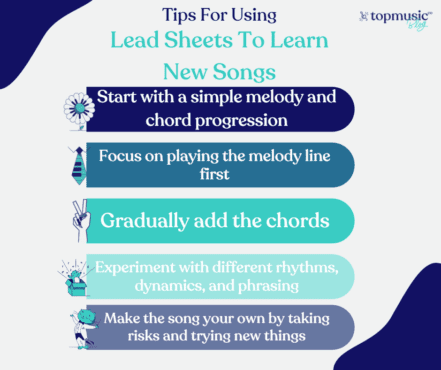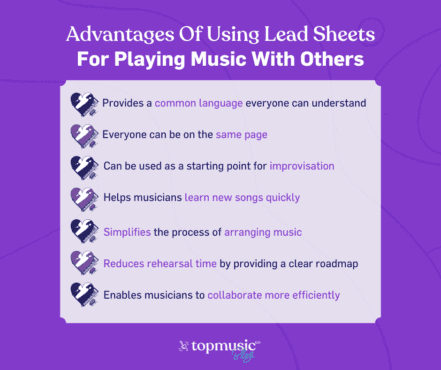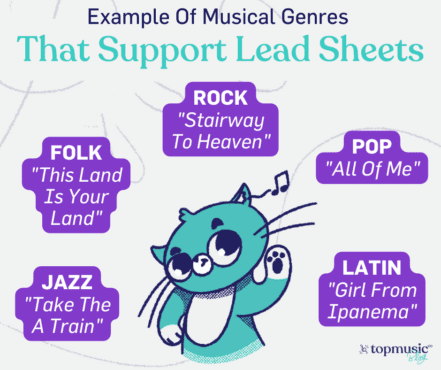Learn how to take your piano students’ piano skills to the next level by teaching them how to play from lead sheets. Discover the benefits and get tips to improve your students’ piano journeys.
If your students want to take their skills to the next level, playing from lead sheets can be a great way to do it.
Using musical notations that show a song’s melody, lyrics, and chords, students are encouraged to improvise and create their arrangements. This in turn can help students develop their improvisation skills and ability to play by ear and transpose on the fly. Lead sheets can also help students better understand music theory as they learn to identify chord progressions and analyze songs differently.
TABLE OF CONTENTS
Reading lead sheets requires a basic understanding of music theory. This includes chords, chord progressions, and notation.
With practice, pianists can learn to read lead sheets and use them to improvise and create their own arrangements.
Related: How To Create A Piano Lead Sheet From Any Song
They consist of a simplified music score that displays the components of the song, including
Unlike traditional sheet music, the intricate details of the composition are not included. Instead, they provide a roadmap musicians can use to create their own arrangements.
The melody line is the heart of the song. It’s the part that is sung or played with the highest pitch.
In a lead sheet, the melody line is written in standard notation If your students need to get more familiar with standard notation, don’t worry! They can learn the basics fairly quickly. (If you want tips on teaching music theory, click here.)
The melody line is usually found on the top staff of the lead sheet.
Chord symbols are the letters and symbols that appear above the staff. They indicate the song’s harmony and tell you which chords to play with each measure. Chord symbols are usually shorthand, such as “C” for C major, or G7 for G dominant 7th chord.
Teaching your students chord symbols is crucial if they’re unfamiliar.
Once your students have a grasp of the melody line and chord symbols, it’s time to combine them.
Start by teaching them the melody line slowly and then adding the chords in the appropriate places. Playing the melody and chords together may take some practice, but they will be able to do it with time.
Reading lead sheets can be a valuable tool for musicians of all levels. So go ahead and teach this skill to your students – you never know what musical magic they might crate!

Lead sheets can be used to learn various musical genres, from jazz to pop and classical.
Here is a list of songs you can use to practice with:
With lead sheets, your students can create their own unique song interpretations by focusing on the melody and chords.
Related: 9 Reasons why Playing Lead Sheets is Essential for Piano Students
There are sometimes situations where pianists need to play music with others but don’t have the time to learn a complicated arrangement. This is when lead sheets can be an ultimate game-changer!

Remember this is just a starting point!
Related: How Bach Would Teach Piano Lead Sheets
Lead sheets are commonly used in jazz, pop, and rock music, but they can also be applied to various musical genres. Here are a few examples:
By focusing on the melody and chord progression, you can encourage your students to create their own unique arrangement and make the song their own.

Lead sheets can be a powerful tool for advanced musicians, allowing for chord substitutions, reharmonization, and arrangement creation.
Chord substitutions and extensions are a great way to add complexity and interest to a lead sheet.
For example, replace a basic major chord with a more complex chord, like a major seventh or ninth.
You could also teach your students how to substitute chords from a different key to create a new harmonic context. They can create unique arrangements that showcase their creativity and musicianship by experimenting with various chord substitutions and extensions.
Reharomization is the process of changing the harmonic structure of a song. This can involve changing the chord progression, adding new chords, or altering existing chords.
Reharmonization is often used in jazz and other improvisational genres to crate new harmonic contexts and add interest to a familiar melody.
Using lead sheets as a starting point, your students can experiment with different reharmonization techniques and create a unique arrangement showcasing their musical voice.
Lead sheets can also be used as a starting point for creating more complex arrangments.
Adding additional parts, like counterpoint, harmony, or rhythm, can make a fuller sound that showcases the melody and chord progression.
You can also encourage your students to experiment with different instrumental combinations, like a string quartet or brass ensemble, to create a unique arrangement that showcases the song in a new light.
By using lead sheets as a foundation, your students can create a complex and compelling arrangement that showcases their arranging skills.
If you can see the importance and benefit of teaching your students to play from lead sheets but don’t feel confident teaching them, TopMusicPro has a course perfect for you.
“Taking The Lead Course with Forrest Kinney” will show you how to teach your students to play from lead sheets, create their own arrangements, and learn how to play ‘freely’.
This course is available to purchase as a one-off, and is also available to Studio and Evolution members of TopMusicPro.
